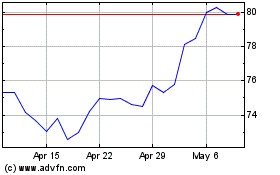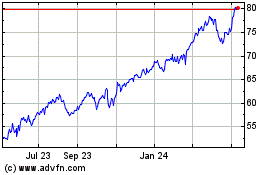By Leslie Scism, Nicole Friedman and Tess Stynes
American International Group Inc. swung to a quarterly profit
but suffered a setback in its turnaround effort for its
property-casualty insurance unit, while four other big insurers
reported stronger-than-expected operating results for the third
quarter.
Analysts at Evercore ISI dubbed Wednesday as "Insurance Super
Day" with life insurers MetLife Inc., Prudential Financial Inc. and
Lincoln National Corp., along with car and home insurer Allstate
Corp. and AIG, reporting results after the closing bell.
MetLife, in one of its last few quarters as the U.S.'s biggest
life insurer by assets, said its results were buoyed by a 6%
increase in net investment income to $5.2 billion. That gain was
driven by a strong performance of private-equity holdings and the
sale of a real-estate joint venture interest.
Prudential, which is set to succeed MetLife as the biggest life
insurer, highlighted strength in its international business, along
with flows in its retirement and asset management divisions.
The improved results at both of those companies come despite a
tough environment for sales of many of their interest-rate-related
products.
Smaller peer Lincoln National Corp. said its operating earnings
for the quarter marked a record, thanks to strong life mortality
and group protection loss ratios. And car and home insurer Allstate
Corp. reported higher property-liability insurance premiums but a
big increase in catastrophe losses.
At AIG, results fell below the expectation of Wall Street
analysts, though they did top the poor performance of the
year-earlier quarter, when the company took a restructuring
charge.
AIG posted operating income of $1.1 billion, or $1 a share, up
from $691 million, or 52 cents a share, the year before when
results fueled activism from billionaire investors Carl Icahn and
John Paulson. Mr. Paulson and a deputy to Mr. Icahn were added to
AIG's board in May. Analysts were expecting $1.21 a share in
operating earnings.
The latest results were hurt by a charge of $404 million, or 37
cents a share, to recognize losses in a portfolio of "structured
settlements" that the company has designated for sale as part of
its effort to streamline and return more capital to
shareholders.
AIG's setback was a $306 million strengthening of reserves for
policies sold to U.S. businesses in years past. AIG, which didn't
specify the years, said the strengthening related to casualty and
property lines written by managing general agents.
The reserve boost drove AIG's "loss ratio" -- which reflects the
percentage of each premium dollar that goes to pay claims and
related expenses -- to 77.7%, up from 72.8% the year before. It
comes on top of a $3.6 billion pretax strengthening that AIG took
in last year's fourth quarter, as AIG sought then to get reserves
in shape.
AIG highlighted that the quarter included many signals that
results are improving. Several divestitures and reinsurance pacts
were negotiated, mostly to better focus AIG, and cost-cutting is
running ahead of plan, with expenses down 12% from the prior-year
period, the company said. The percentage of each premium dollar
that goes to claims shrank to 27.6% from 29.5%.
The company's "accident year loss ratio," which is a metric
watched closely in AIG's turnaround because it reflects the
profitability of business on a forward-looking basis, is 64.8%,
improved from the 66.7% of the year-earlier period. But that was a
worsening of the 62.4% in the second quarter. The prior-quarter
results had drawn cheers from investors.
AIG said it remains committed to lowering the accident year loss
ratio, despite what Chief Executive Peter Hancock called "volatile
quarterly results."
As part of its turnaround, AIG is committed to returning at
least $25 billion to shareholders through buybacks and dividends in
2016 and 2017. It said it has returned $10.8 billion to
shareholders year-to-date through Nov. 2. AIG's board authorized an
additional increase in repurchase authorization of $3 billion.
At MetLife, operating earnings more than doubled to $1.4
billion, or $1.28 a share, easily beating the $1.14 expected by
analysts. It net results, however, included $683 million in
derivative losses reflecting changes in interest rates, equity
markets and foreign currencies, along with a $223 million
write-down tied to Brighthouse Financial, the new name for its
life-insurance operations.
Prudential's operating earnings, meanwhile, rose 7.3% to $1.91
billion, or $2.66 a share, above Street expectations for $2.49.
Lincoln Financial's operating earnings rose 53% to $ 441
million, or $1.89 a share. Revenue decreased 5.5% to $3.53 billion.
Analysts expected per-share operating profit of $1.62 and revenue
of $3.44 billion. Lincoln's board also approved a 16% increase in
the company's quarterly dividend.
At Allstate, operating earnings fell 22% to $474 million, or
$1.26 a share. Premiums written increased 2.1% to $8.31 billion.
Analysts expected a per-share operating profit of $1.25 and net
premiums written of $8.35 billion. Pretax net catastrophe losses
increased to $481 million from $270 million a year earlier, mostly
from wind and hail storms.
Write to Leslie Scism at leslie.scism@wsj.com, Nicole Friedman
at nicole.friedman@wsj.com and Tess Stynes at
tess.stynes@wsj.com
(END) Dow Jones Newswires
November 02, 2016 17:28 ET (21:28 GMT)
Copyright (c) 2016 Dow Jones & Company, Inc.
American (NYSE:AIG)
Historical Stock Chart
From Mar 2024 to Apr 2024

American (NYSE:AIG)
Historical Stock Chart
From Apr 2023 to Apr 2024
